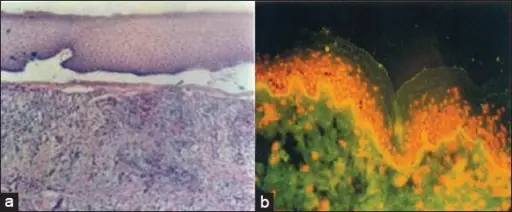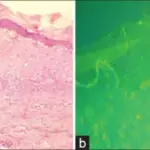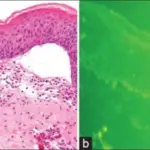Cicatricial pemphigoid is a disease of the skin and the mucosa membranes that affects the subepidermal layer.
What is the Pathology of Cicatricial Pemphigoid?
The pathology of cicatricial pemphigoid is the scientific study of the disease of the skin and the mucosal layer.
-Etiology: The cause of cicatricial pemphigoid is not well known but can be drug-induced and presence of antibodies.
-Genes involved: COL17A1.
-Pathogenesis: The sequence of events that lead to cicatricial pemphigoid occurs when the antibodies that are used to maintain adhesion of tissue fail to do so due leading to separation of the dermis and the epidermis hence the formation of blisters.
-Morphology: The morphology associated with cicatricial pemphigoid shows the following depending on whether it is on the eye or the mucosa, tense blisters and erosions, symblepharon on the eye.
-Histology: The histology associated with cicatricial pemphigoid shows clusters of erythrocytes in the subepithelial space, neutrophils, and lymphocytes are present together with the plasma cells.
How does Cicatricial Pemphigoid Present?
Patients with cicatricial pemphigoid typically affect the elderly mostly females with a mean age of 60-70 years. The symptoms, features, and clinical findings associated with cicatricial pemphigoid include continuous painful lesions of the skin depending on the location, erosions, inflammation, decreased tear and mucous production, and difficulty in breathing.
How Is Cicatricial Pemphigoid Diagnosed?
The cicatricial pemphigoid is diagnosed by physical exam, direct and indirect immunofluorescence, and biopsy.
How is Cicatricial Pemphigoid Treated?
The cicatricial pemphigoid is treated intralesional corticosteroids, topical therapy.
What is the Prognosis of Cicatricial Pemphigoid?
The prognosis of cicatricial pemphigoid is good if it is detected early but is poor if detected late due to its poor response to treatment.



